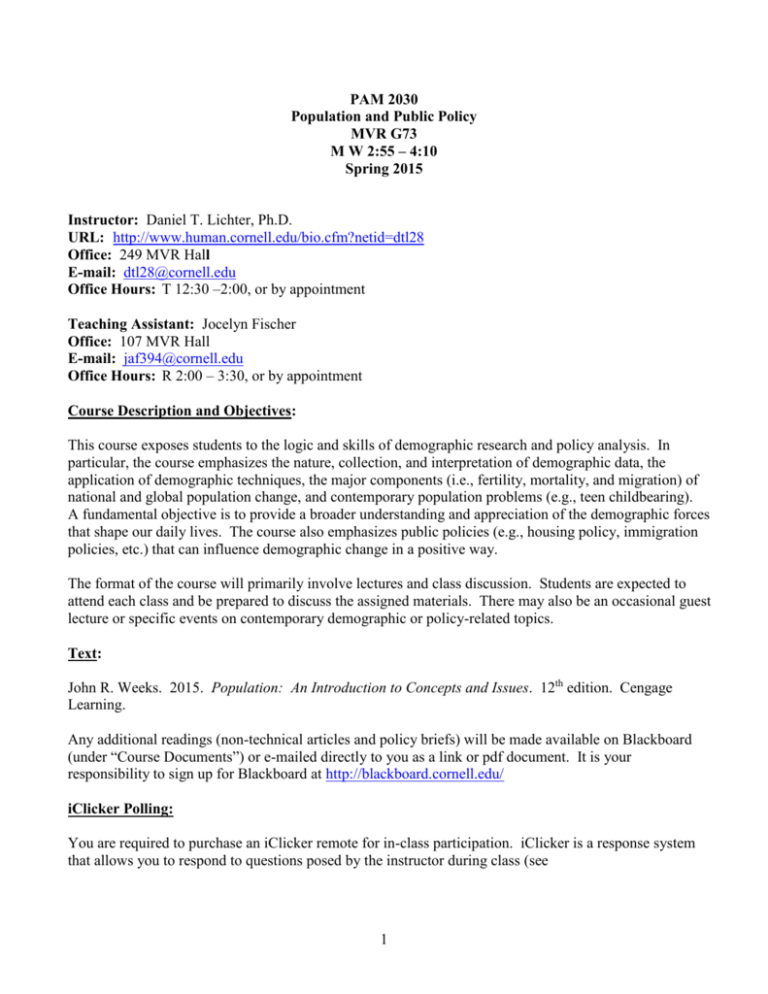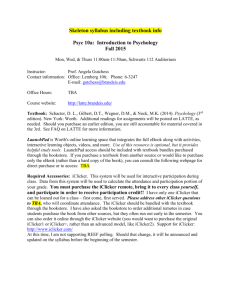PAM 336 - Cornell University College of Human Ecology
advertisement

PAM 2030 Population and Public Policy MVR G73 M W 2:55 – 4:10 Spring 2015 Instructor: Daniel T. Lichter, Ph.D. URL: http://www.human.cornell.edu/bio.cfm?netid=dtl28 Office: 249 MVR Hall E-mail: dtl28@cornell.edu Office Hours: T 12:30 –2:00, or by appointment Teaching Assistant: Jocelyn Fischer Office: 107 MVR Hall E-mail: jaf394@cornell.edu Office Hours: R 2:00 – 3:30, or by appointment Course Description and Objectives: This course exposes students to the logic and skills of demographic research and policy analysis. In particular, the course emphasizes the nature, collection, and interpretation of demographic data, the application of demographic techniques, the major components (i.e., fertility, mortality, and migration) of national and global population change, and contemporary population problems (e.g., teen childbearing). A fundamental objective is to provide a broader understanding and appreciation of the demographic forces that shape our daily lives. The course also emphasizes public policies (e.g., housing policy, immigration policies, etc.) that can influence demographic change in a positive way. The format of the course will primarily involve lectures and class discussion. Students are expected to attend each class and be prepared to discuss the assigned materials. There may also be an occasional guest lecture or specific events on contemporary demographic or policy-related topics. Text: John R. Weeks. 2015. Population: An Introduction to Concepts and Issues. 12th edition. Cengage Learning. Any additional readings (non-technical articles and policy briefs) will be made available on Blackboard (under “Course Documents”) or e-mailed directly to you as a link or pdf document. It is your responsibility to sign up for Blackboard at http://blackboard.cornell.edu/ iClicker Polling: You are required to purchase an iClicker remote for in-class participation. iClicker is a response system that allows you to respond to questions posed by the instructor during class (see 1 http://www.it.cornell.edu/services/polling/howto-students.cfm). iClickers may be purchased through The Cornell Store. iClickers will be used in this course for two main purposes: A. Attendance. Class will usually begin with one graded, multiple-choice question. Attendance questions will be taken from course readings due on that day. The attendance question will be posted on screen shortly before class and will remain on screen for 90 seconds after class starts. Two points will be given for a correct response. One point will be given for an incorrect response. Zero points will be given for no response. B. Active learning assessment, and feedback. Periodic, ungraded, multiple-choice questions will be used to test students’ learning of lecture and reading materials. The use of electronic polling devices such as iClicker engages students in “active learning” which has been shown to be associated with greater student learning and outcomes. It is important you bring your iClicker to every lecture. Participation on the graded iClicker questions will determine attendance for each lecture and responses on the ungraded questions will determine class participation. You must register your iClicker to receive attendance points, and have participation scores attached to your name. Please register your iClicker immediately upon purchase. Go to http://www.it.cornell.edu/services/polling/howto-students.cfm#register and follow the instructions under “To register your i>clicker if using Blackboard.” Student Evaluation: A. Examinations. There will be one mid-term and one final examination covering lecture, textbook, and supplemental reading materials. Examination dates are tentatively scheduled for March 11 and during the final exam week. Makeup exams will be considered only if the instructor is notified in advance or if a medical excuse is obtained. Exams will be made up of a combination of multiple-choice and short answer questions. B. Homework. There will be three short take-home assignments that require using various demographic techniques or providing short reactions to some of the topics/readings studied in this course. All assignments should be turned in at the beginning of class on the date due, unless alternative arrangements have been made with the professor. Late assignments will be penalized one half-grade for each day late, and will only be accepted for three days after the due date. C. Participation. Students will be evaluated for in-class participation assessed using iClicker polling. Attendance questions will be graded as noted above. In-class participation questions will not be graded but students will be given points for participating. D. Grading. Each exam is worth 30% of the final grade. Homework exercises are worth 30% of the final grade. Participation is worth 10% of the final grade. There will be some opportunities to obtain extra credit, e.g., by attending outside lectures and writing up short critiques or summaries. These will be announced throughout the semester and on Blackboard. Extra credit does not take the place of other 2 performance indictors (e.g., exams and exercises) but can benefit students whose cumulative scores are on the border between grades. Cornell Code of Academic Integrity: The University Faculty Senate has developed a Code of Academic Integrity by which each student is expected to abide. Any work submitted for academic credit should be the student’s own work. All outside assistance and sources shall be acknowledged. See http://cuinfo.cornell.edu/aic.cfm Disability accommodations: In compliance with section 504 of the Rehabilitation Act of 1973 and the Americans with Disabilities Act, reasonable accommodation will be provided to students with documented disabilities. Students with disabilities must provide the College with appropriate documentation of their disability before any accommodation can be made. Reasonable accommodation will be provided, on a case-bycase basis. Course Schedule and Major Due Dates: Dates Topics and Readings January 21 What is Demography? How it Informs Public Policy Weeks, Chapter 1 (Introduction to Demography) January 26 U.S. and Global Population: Reasons for Public Concern Weeks, Chapter 2 (Global Population Trends) January 28 Malthus and the Population Debate Weeks, Chapter 3 (Demographic Perspectives) Weeks, Chapter 11 (Population and the Environment) February 2 Rates and Population Composition Weeks, Chapter 4 (Demographic Data) February 4 Population Aging and Public Support Weeks, Chapter 8 (The Age Transition) 3 February 9 America’s Changing Color Line Putman, Robert D. 2007. "E Pluribus Unum: Diversity and Community in the Twenty-first Century." Scandinavian Political Studies 30:137-174. February 11 Mortality: Concepts and Measurement Weeks, Chapter 5 (The Health and Mortality Transition) February 16 No Class February 18 Promoting Longevity: Who Lives? Who Dies? Pollard, Kelvin, and Paola Scommegna. 2013. The Health and Life Expectancy of Older Blacks and Hispanics in the U.S. Today’s Research on Aging #28. Population Reference Bureau. February 23 Population Health Lamptey, Peter R., Jami L. Johnson, and Marya Khan. 2006. “The Global Challenge of HIV and AIDS.” Population Bulletin 61(1). February 25 Fertility: Concepts and Measurement Weeks, Chapter 6 (The Fertility Transition), Pp. 234-241 DUE: ASSIGNMENT #1 March 2 Fertility Transitions and Family Planning Weeks, Chapter 6 (The Fertility Transition) March 4 Reproductive Rights and the Contraceptive Revolution Jones, Rachel K., and Jenna Jerman. 2014. “Abortion Incidence and Service Availability in the United States, 2011.” Perspectives on Sexual and Reproductive Health 46 (March): 3-14. March 9 Out-of-Wedlock Childbearing: Cause for Concern? Hoffman, Saul. 2006. By the Numbers: The Public Costs of Teen Childbearing. Washington, DC: National Campaign to Prevent Teen Pregnancy. March 11 MID-TERM EXAM 4 March 16 Why Marry? Threats to Traditional Marriage Weeks, Chapter 10 (The Family and Household Transition) Cherlin, Andrew. 2010. “Demographic Trends in the United States: A Review of Research in the 2000s.” Journal of Marriage and Family 72: 403 – 419 March 18 Marriage and Public Policy Kane, Andrea, and Daniel T. Lichter. 2006. Reducing Unwed Childbearing: The Missing Link in Efforts to Promote Marriage. CCF #37. Washington DC: Brookings Institution, Center on Children and Family. March 23 Interracial Marriage and Changing Racial Boundaries Passel, Jeffrey S., Wendy Wang, and Paul Taylor 2010. Marrying Out: One-inSeven New U.S. Marriages is Interracial or Interethnic. Washington, DC: Pew Research Center. March 25 New Families: Implications for Children Amato, Paul. 2005. “The Impact of Family Formation Change on the Cognitive, Social, and Emotional Well-Being of the Next Generation.” Future of Children 15 (Fall): 75-96. DUE: ASSIGNMENT #2 March 30, April 1 Spring Break April 6 Migration: Concepts and Measurement Weeks, Chapter 7, Pp. 262-305 April 8 Urbanization: U.S. and Global Dimensions Weeks, Chapter 9 (The Urban Transition) April 13 Why Blacks and Whites Live in Different Neighborhoods Farley, John E., and Gregory D. Squires. 2005. “Fences and Neighbors: Segregation in 21st Century America.” Contexts 4(1):33-39. April 15 Immigration and Public Policy Martin, Philip and Elizabeth Midgley. 2010. “Immigration in America 2010” Population Bulletin Update (June). 5 April 20 Immigration and Assimilation Waters, Mary C., and T.R. Jimenez. 2005. “Assessing Immigrant Assimilation: New Empirical and Theoretical Challenges.” Annual Review of Sociology 31:105-125. April 22 Poverty and Welfare Policy Beller, Emily, and Michael Hout. 2006. “Intergenerational Social Mobility: The United States in Comparative Perspective.” Future of Children 16(Fall): 19-36. Due: ASSIGNMENT #3 April 27 Concentrated Poverty Bischoff, Kendra and Sean F. Reardon. 2014. “Residential Segregation by Income, 1970-2009.” In Diversity and Disparities: America Enters a new Century, edited by John Logan. New York: The Russell Sage Foundation. April 29 No Class May 4 Economic Demography Lee, Marlene A and Mark Mather. 2008. “U.S. Labor Force Trends.” Population Bulletin 63(2). May 6 Global and U.S. Inequality: Why It Matters Mather, Mark, and Beth Jarosz. 2014. “The Demography of Inequality in the United States.” Population Bulletin 69(2). May 11-19 FINAL EXAM (TBA) 6







